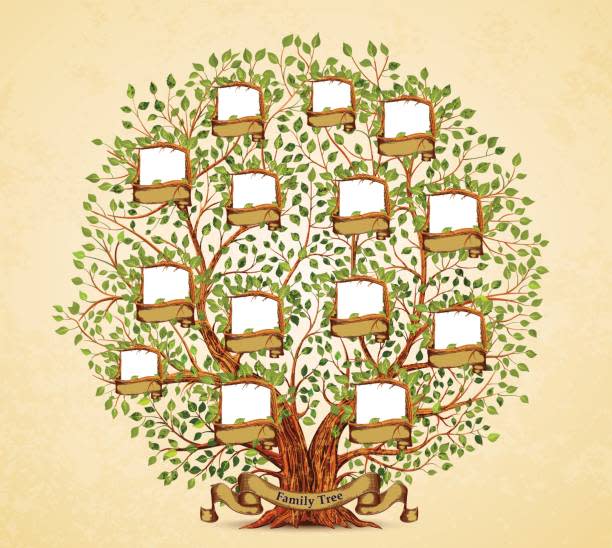
How To
How To Create Your Family Tree | GoodTrust
Have you ever wondered about your family tree? Or taken a DNA test to find out where in the world your ancestors came from? Do you know your family history beyond your grandparents or great-grandparents? Now is the time to answer these questions. In this article you will learn about family trees, family history, and how to create your own legacy after you're gone.
What is a family tree?

A family tree is a diagram that maps lineage and relationships between your previous bloodline ancestors over several generations. It usually starts with one family member in the past, and branches out to the most recent additions to the bloodline. The "tree" in a family tree symbolizes the different branches of different generations, including marriages, children and deaths. Just like a tree has a stem, a family tree usually starts with one person and branches out from their bloodline. Like your family, a tree is a living organism that is all based on one foundation. Or at least as far back as you can go.
Who is included in a Family Tree?
But who is included in a family tree? You might have asked yourself this question before reading this article, and you may have thought about whether or not to include different family members. The answer is quite simple: everyone. A family tree does not only show the different direct bloodline history, but also relationships with other kin. More importantly, a family tree is your family history and therefore anything you want it to be.
Usually included in a family tree are:
Parents Parent relationships are an important part of the family tree. Even if you are missing parts of the tree, make sure to fill in as much information as possible.
Children Children are another essential part of the tree. Besides any blood-related children, a family tree usually includes:
Adoptive children
Step-children
Foster-children
Previous spouses Even if previous relationships didn’t work out, make sure to include them in your tree. Complex family trees are not a bad thing, and often show how intricate someone's life was.
Example: Yourself If you take yourself as an example, then you can start with your parents and their parents. Then you can add your siblings, aunts and uncles, and cousins. Add their partners and children, and you already have your own family tree.
How to create my own Family Tree
1. Collect Information

Collecting information on your family and your ancestors is essential for your family tree. You can start by writing down all the information you already have. Try going back in the family line as far as possible, and note down birthdays as well as relationships and connections. Once you reach the end of your own knowledge, you can start asking your family members questions. You can limit your tree to your family's knowledge, but you don’t have to. Other resources are:
Family pictures/Albums: Look through old family photos and albums and see if you can find any additional information on.
Marriage and Family Bibles: Family bibles are a great resource when tracking family history. They often include births, deaths, baptisms, confirmations and marriages; Family Bibles usually include a "family record" or "family registry" section to capture this information. Sometimes family members add certificates, letters, newspaper cuttings and photographs inside the bible.
Diaries, Journals, Letters: Your parents or grandparents may have kept their journals or diaries somewhere. Those records are often helpful when looking for relationships or birthdates.
Obituaries and Newspaper records: You can look through old newspaper articles and local obituaries for any death records dated a while back.
Certificates - Death, Birth, Marriage: Look for any certificates in your families past records. There are many national and public records for death certificates and birth certificates.
Databases: There are several databases you can utilize to find more information about your ancestors. You can use these databases to find records of previous ancestors and marriages, and maybe some of their life story. Acestry.com provides free obituary and genealogy databases to search in.
DNA Tests: Nowadays many people use DNA testing to find out where their ancestors came from. DNA tests can give a very general overview of your roots. We don’t advise you to purely rely on those results, as they can not accurately determine a specific area of hereditary ancestry.
Museums, Courthouses and Libraries: Local government entities or museums and libraries are another great resource for public records. Check their databases for last names, death or birth dates.
2. Decide where to start
After you have completed your research, it is time to start the family tree. You can start with yourself and work your way up, or you can start with the furthest family member you were able to find. Collect all the information you have found in a folder, preferably as a digital copy. If you want to save your family history for future generations, make sure to digitalize all the information you have gathered. Look and see how far back in your ancestry you are able to go.
3. Create the tree

Now it is time to create the tree. There are many different tools to creating a family tree. You can draw a family tree the old school way - on paper with a pen or pencil. There are also several websites with family tree templates and tools you could use.
Another option is simply using a Word or Excel file. We advise using any digital tool listed above; if you ever want to share your family tree with your children, you want to make sure it is stored sound and safe. Try to draw connections as accurately as possible. Leave space for birthdays and death dates for the family members you have the information on. Draw horizontal lines for marital relationships, and vertical lines for children or descendants of those relationships. The diagram does not need to be in the shape of an actual tree, but stick to a shape that is easy to follow. Make sure to include:
First and last name
Birthday
Date of Death
Relationships
Place of birth and death (if known)
Do not give up if you don’t have the full records of all your family members. You might face knowledge gaps for some parts of the tree, and might also run into dead ends. If you do, just continue the tree and other parts of the family you are aware of. If you can’t find information about their birthplace, first or last name or place, include them anyway.
4. Share the Tree
Congratulations! You have now created your own family tree. This is exciting news and you should share it with your family and friends immediately. Make sure to digitally safe a copy of your tree, so that it won't get lost over time. You can also share it on your social media to your friends and family.
With Future Messages, you can also share your family tree as a surprise anytime in the future! Future Messages from GoodTrust allow you to create a customized video, photo, or text message to be automatically sent to anyone on a date you decide. You can even schedule messages for after your death. Like a digital time capsule. Make sure your family history is never forgotten.